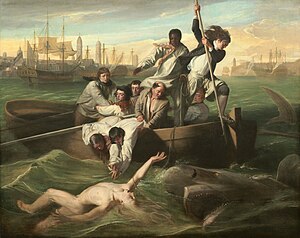Watson and the Shark

Watson and the Shark is the title of a 1778 oil-on-canvas painting by John Singleton Copley. It depicts the rescue of Brook Watson from a shark attack in Havana, Cuba.
The painting is based on a real attack that took place in Havana harbour in 1749. Brook Watson was a 14-year-old orphan, serving as a crew member on a trading ship. While swimming alone in the harbour, he suffered multiple attacks by a single shark. On its first attack, the shark bit off a chunk of flesh from Watson's right leg below the calf; on the second attack, it removed his foot at the ankle. The crew of a small boat, who had been waiting to escort their captain to shore, fought off the shark and rescued Watson. His leg was amputated below the knee, but he went on to live a full life, including a term as Lord Mayor of London. The attack is the earliest shark attack to be fully documented.
Copley had become friends with Brook Watson after he arrived in London in 1774, and produced three versions of the painting depicting the 1749 shark attack. It is likely that Watson commissioned the original from Copley; on his death he bequeathed it to Christ's Hospital, which retained a copy of the picture after selling the original, with the hope that it would prove "a most usefull Lesson to Youth". It was the first in the series of the large scale historical paintings that Copley would concentrate on after settling in London. The painting is romanticised: the gory detail of the injury is hidden beneath the waves (although there is a hint of blood in the water), and the figure of Watson is based on the statue of the "Borghese Gladiator", by Agasias of Ephesus, which is held in the collection of the Louvre, in Paris. Further apparent influences are Renaissance art, and the ancient statue of Laocoön and his Sons that Copley may have seen in Rome. Undoubtedly, Copley was influenced by Benjamin West's The Death of General Wolfe, and the growing popularity of romantic painting.
Copley had never visited Havana, and it is likely that he had never seen a shark, much less a shark attack. It is probable that he gleaned details of Havana harbour from prints and book illustrations: he includes the real landmark of Morro Castle in the background of the painting. The shark is less convincing; it includes details not found in sharks, such as forward-facing eyes and lips. While not identifiable as any specific species, it is still clearly recognizable as a shark.
Comments